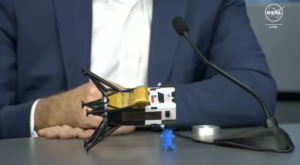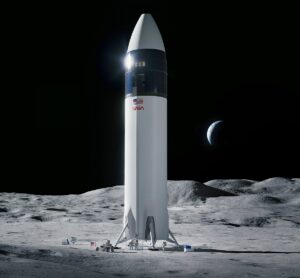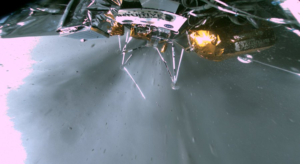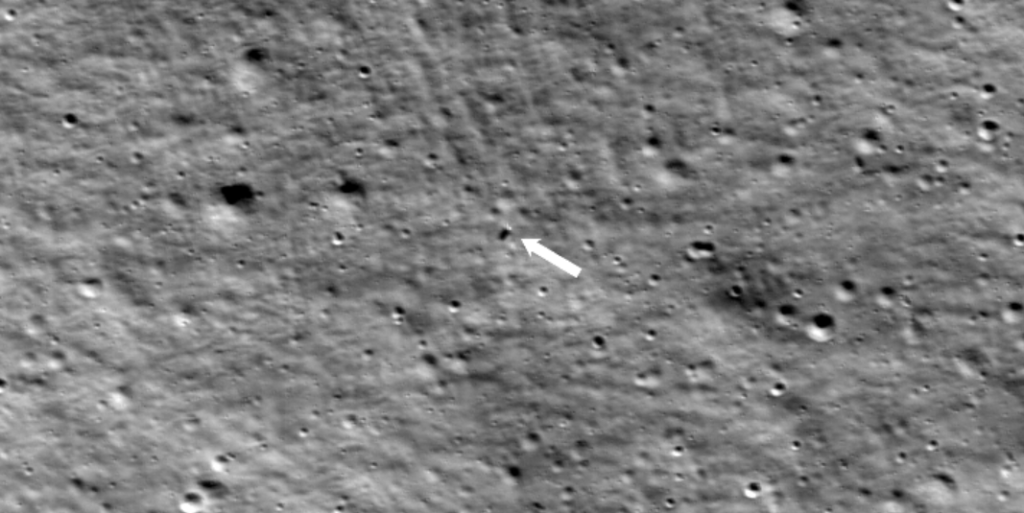
New Images of Odysseus On The Moon Have Been Released
After around 4 days since the Odysseus lander made contact with the Moon, we have finally received some actual images of the lander on the surface. This includes distant images from NASA’s Lunar Reconnaissance Orbiter along with some onboard cameras. Unfortunately, the quality is still far from ideal.
That being said, it gives us more insight into the current state of the lander along with what to expect in its final days. Here I will go more in-depth into the new images, what they tell us, the upcoming lunar night, and more.
New Lander Images
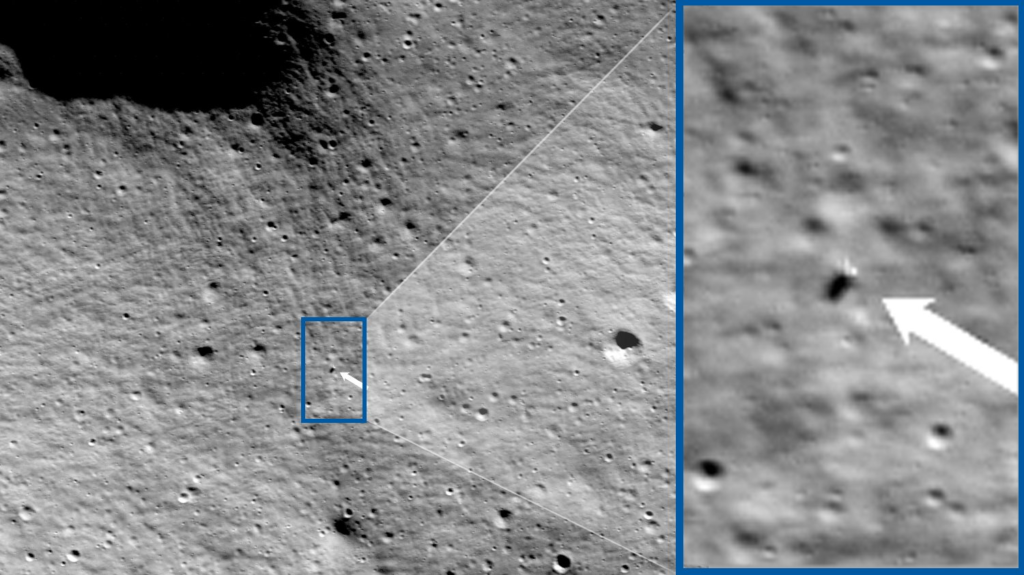
A few days ago on the 22nd, after a few complications with the lander’s laser rangefinders, which it uses to help it land, Odysseus was confirmed to have made contact with the Moon. While at first, the company believed this was upright and fully successful, we learned a few days later that it was actually on its side. At the same time, other than images leading up to the landing attempt, we hadn’t received any images of the lander on the surface. Thankfully this changed earlier this morning.
Intuitive Machines finally released a few images both from a separate Moon orbiter along with onboard cameras. In the first image, which you’ll have to excuse the low quality as this is what was provided, you can partially see the lander. The company was quoted saying, “After understanding the end-to-end communication requirements, Odysseus sent images from the lunar surface of its vertical descent to its Malapert A landing site, representing the furthest south any vehicle has been able to land on the Moon and establish communication with ground controllers” they said. Due to the quality of the image, it’s very hard to make out exactly the position or even the state of the lander.
In a second onboard image, you can see the lander’s view not long before that actual touchdown attempt. Here the company mentioned, “Odysseus captured this image approximately 35 seconds after pitching over during its approach to the landing site. The camera is on the starboard aft-side of the lander in this phase.” They went on to say “As part of Odysseus’ descent onto the lunar surface, Hazard Relative Navigation algorithms detected nine safe landing sites within the targeted south pole region.”
They then released images from NASA’s Lunar Reconnaissance Orbiter which I believe gives the best view of the lander despite the quality. Here, as highlighted by the blue box and arrow, you can see a very small white object casting a shadow below it. In relation to this image, they said, “Images from NASA’s Lunar Reconnaissance Orbiter Camera team confirmed Odysseus completed its landing at 80.13°S and 1.44°E at a 2579 m elevation. After traveling more than 600,000 miles, Odysseus landed within 1.5 km of its intended Malapert A landing site, using a contingent laser range-finding system patched hours before landing” they said. Looking even closer at the image, it does appear to be on its side as it looks longer than it is tall, suggesting it did in fact tip over. The lander is 4.6 meters tall and 1.6 meters in diameter.
They also provided a sequence of images of the exact site before and after the landing attempt. This makes it even more clear the lander’s position and state. You can clearly see the addition of the lander in the second image along with its shadow produced by the sun. Based on what Intuitive Machines has said since the 22nd, this might be some of the only images we get. While they haven’t said it directly, it’s very possible that the sideways orientation and misalignment of certain antennae are hindering the process of receiving quality images. We do know that one of the main ways they planned to capture the landing on camera was not deployed. Specifically, the lander was equipped with EagleCam, an instrument that was designed to deploy from Odysseus about 100 feet (30 meters) above the lunar surface and photograph the craft’s touchdown from below. Unfortunately, they decided to power down EagleCam during landing and not deploy the device because of a necessary software patch related to navigation complications. To add to all this, it sounds like the mission will also be ending early.
Running Out of Sun

The original plan was for Odysseus to land safely and operate on the surface for about a week before it would run out of sunlight and power. New information from Intuitive Machines however suggests the mission could be cut short. In a tweet earlier this morning the company said, “Flight controllers intend to collect data until the lander’s solar panels are no longer exposed to light. Based on Earth and Moon positioning, we believe flight controllers will continue to communicate with Odysseus until Tuesday morning.” This statement leaves a bit open to interpretation as they could mean this Tuesday or next Tuesday. With it being Monday afternoon, the first option would mean Odysseus only has around 16 hours or so hours left of operation before it’s done.
This would be earlier than the original estimate and hope for the lander’s lifetime. Intuitive Machines stated that it expected the lander to operate for about seven days until the lunar night eventually sets on the south pole of the Moon, rendering Odysseus inoperable. To add to this, a few days ago during the briefing, the IM CEO suggested a “best-case scenario” would be 9 to 10 days of operations after landing, even considering the sideways orientation. With it landing on the 22nd, 10 days later would be March 3rd, and next Tuesday is the 5th or 12 days after landing. If they were to lose communication with the lander tomorrow morning, that would be a mission total of around 4 and a half to 5 days.
The problem simply comes down to sunlight. It seems that the sideways orientation could have a larger impact than initially expected. A few panels we know are not in an ideal position such as the top solar panel and basically each of the side panels. While they still are gathering energy, they are in a much less efficient orientation and position. This seems to be shortening the lander’s lifespan.
When planning the mission, according to Intuitive Machines, the lander was not designed to withstand the lunar night and requires sunlight upon its solar panels to power its operations. It’s important to point out that a full lunar day is 28.3 Earth days long, with 14.15 Earth days of sunlight, and 14.15 Earth days of darkness. Since the lander touched down on the Moon at what could be called the lunar noon-time, approximately seven Earth days after the lunar sunrise for that lunar day, the lander would only have approximately 7 remaining Earth days of sunlight left before the next lunar sunset. Accordingly, the Odysseus system has been programmed so that after seven days, once the sun has finally set over the landing site, it will fully and finally shut down. This is not the best news for the lander which likely needed as much time as it could get to complete various science and gather more data.
Focusing back on the landing, the images provided by the Moon orbiter also give us some insight into how the lander might have tipped. The new images show that the spacecraft touched down about 1.5 kilometers from its intended landing site near the Malapert A crater. While that sounds like a big miss, the CEO said at the recent briefing that he expected a landing accuracy of within two to three kilometers based the performance of the spacecraft’s optical navigation system. This means the lander is partially in charge of choosing the best site to land. This however can add some complications and force a landing at a site that’s not ideal.
Thanks to the new images, the landing site is described by NASA as a “degraded” crater about one kilometer across. Also, the slope of the landing site is relatively steep at around 12 degrees. This reality could have impacted Odysseus’s landing attempt adding to the sideways movement and increasing the chances of the lander tipping.
As partially mentioned prior, they reported that team members discovered that Odysseus’ laser rangefinders, which the lander uses to determine its altitude and horizontal velocity, weren’t working properly. As a result, they decided to switch over to an experimental NASA instrument that Odysseus was carrying, pressing it into service for vital landing operations. When it comes to landing on the Moon, it’s immensely important to measure and ensure the vehicle determines the best landing site considering the slope of the ground and frequent craters.
All this being said, we also aren’t fully sure the impact this will have on the payloads. It seems that Intuitive Machines is also not exactly sure as they continue to communicate and work to keep the lander operating. The bright side is that a lot of the experiments began soon after the launch and have been collecting data since then. This should allow a majority of the science to be completed despite the sideways landing. In the coming days, we can hope to receive more information on the payloads, the lander’s energy state, and more.
Conclusion
After a few days, we finally received some images of Odysseus on the surface. While not very good quality, they help paint a picture of the lander’s position and its surrounding environment. We will have to wait and see how it progresses and the impact it has on the space industry.

